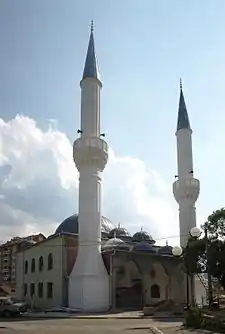Turks in Montenegro
Turks in Montenegro, also known as Turkish Montenegrins and Montenegrin Turks, (Turkish: Karadağ Türkleri) are ethnic Turks who form an ethnic minority in Montenegro.
| Total population | |
|---|---|
| 104 (2011 Census)[1] | |
| Languages | |
| Turkish, Montenegrin | |
| Religion | |
| Islam |

History
In 1496 the Ottoman Empire conquered Montenegro which bequeathed a significant Turkish community due to the Ottoman colonisation process. However, in the early 20th century, after the Ottomans were defeated in the Balkan Wars, the majority of Turks along with other Muslims living in the region left their homes and migrated to Turkey.
Demographics
According to the 2011 census, there were 104 Turks living in the country, forming a minority of some 0.02% of the total population.[1] However, the former vice president of the Parliament of Montenegro, Suljo Mustafić, has stated that whilst there are only 50 families which still speak the Turkish language, the population of Montenegrins of Turkish origin is significantly higher.[2]
| Turks in Montenegro[3] | |||||||
| Year | Turks | ||||||
|---|---|---|---|---|---|---|---|
| 1961 | 2,392 | ||||||
| 1971 | 397 | ||||||
| 1981 | - | ||||||
| 1991 | - | ||||||
| 2011 | 104 | ||||||
Age-sex structure
The average age of the Turkish minority is slightly higher than 40 years old. The population is overwhelmingly male (>65%), as there are only 36 females (<35%).
| Age and sex structure of the Turkish minority in Montenegro [4] | |||
|---|---|---|---|
| Age group | Total | Male | Female |
| 0-6 | 11 | 7 | 4 |
| 7-18 | 8 | 3 | 5 |
| 19-25 | 11 | 6 | 5 |
| 26-40 | 21 | 15 | 6 |
| 41-60 | 42 | 28 | 14 |
| older than 60 years | 11 | 9 | 2 |
| Total | 104 | 68 | 36 |
Notable people
- Suljo Mustafić, former Vice President of the Parliament of Montenegro[2]
See also
References
- Statistical Office of Montenegro. "Population of Montenegro by sex, type of settlement, etnicity, religion and mother tongue, per municipalities" (PDF). p. 7. Retrieved 2011-09-21.
- "Adriyatik'te unutulan 104 Türk". Hurriyet. 2011. Retrieved 25 November 2017.
Mustafiç, şöyle konuştu: “Osmanlının buradan ayrılmasının üzerinden 100 yıl geçti. Ancak burada o eski dili konuşan insanların yaşaması bizi çok mutlu ediyor. Burada cami, türbe, tekke gibi tarihi anıtların yanı sıra canlı anıtlarımız da bulunuyor. Burada Türkçe konuşan 50 aile bulunuyor, ancak Türk kökenli insanların sayısı daha yüksektir, fakat zamanla bu insanlar Türkçeyi unutmuşlar...” Sulyo Mustafiç, kendisinin de Türk kökenli olduğunu ve atalarının yüz yıllar önce Karaman'dan Bar'a gelerek yerleştiğini ifade ederek...
- Internet Library Of Serb Culture. "The Ethnic Structure of the Population in Montenegro". Archived from the original on 2013-03-13. Retrieved 2008-10-29.
- Table CG11. Turkish as ethnicity by age and sex, Population Census in Montenegro 2011
- Table CG5. Population by ethnicity and religion, Population Census in Montenegro 2011
- "Adriyatik'te unutulan Türkler". Milliyet. 2011. Retrieved 25 November 2017.